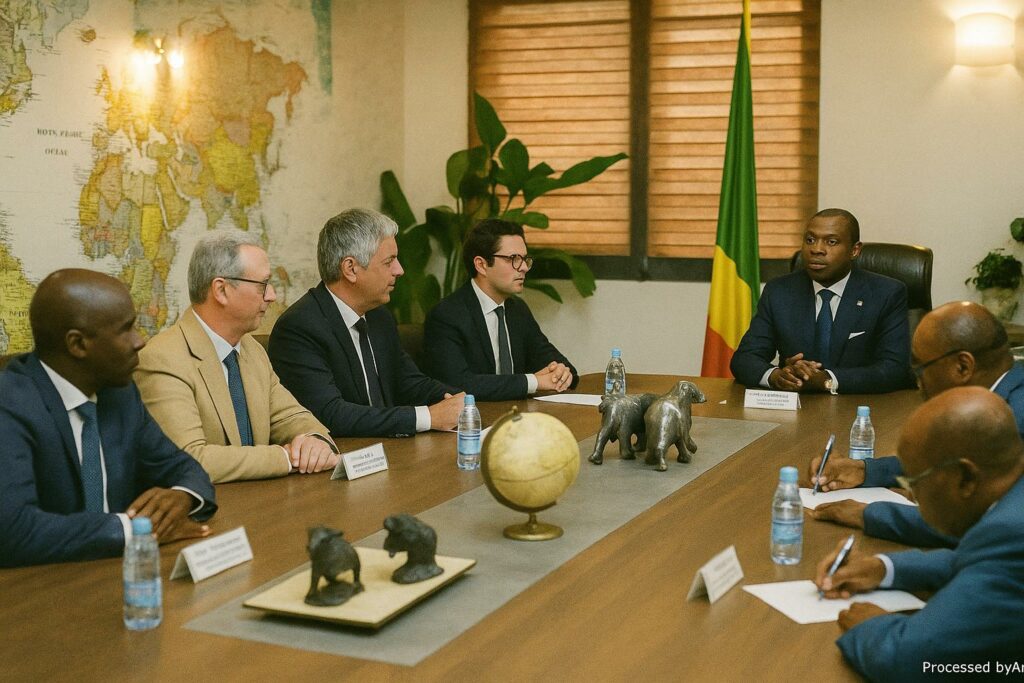Strategic Urban Sanitation Challenges in Brazzaville
A decade of steady demographic growth has stretched Brazzaville’s underground arteries to their limits. According to the World Bank, the Congolese capital has been gaining almost 3 % in population annually, while nearly 40 % of households still rely on informal connections to water and wastewater grids. The Ministry of Urban Sanitation, now led by Juste Désiré Mondélé, has therefore placed the mapping and rehabilitation of buried pipes at the heart of the government’s 2022–2026 National Development Plan. Congolese officials argue that improving subterranean infrastructure is not merely a technical endeavour but a public-health imperative, given the recurrent cholera alerts during the rainy season.
French Expertise Meets Congolese Policy Priorities
On 30 July, Minister Mondélé welcomed a compact yet influential delegation from the French group Nova Detect. The visiting mission, headed by Olivier Aurojo, mayor of Charly and longstanding advocate of decentralised cooperation, arrived with a clear message: French know-how can be aligned with Congolese priorities without imposing an external agenda. “We wish to stand beside Congo as genuine partners, offering technology that answers concrete social and sanitary questions,” Aurojo underlined after the meeting.
Nova Detect’s leadership—Philippe Aymard, Henri Coron and Aristide Dougomales—placed emphasis on co-construction. In private conversations with ACI reporters, they contended that municipal ownership of the data generated by their sensors and ground-penetrating radars remains non-negotiable, an assurance that resonated well in Brazzaville’s circles increasingly wary of data colonialism.
Technological Edge: From Ground-Penetrating Radars to AI Mapping
Fifteen years of operating in France have enabled Nova Detect to refine a portfolio ranging from high-frequency radars that locate galvanised steel pipes a dozen metres below asphalt, to light lidar drones capable of generating three-dimensional urban twins. Those tools will be coupled with the data-management platform Mappia, which promises a unified digital registry of each valve, manhole and service line. Meanwhile, the start-up Mimo Detect is developing machine-learning routines that reportedly triple the detection speed of leaks—a welcome prospect in a city where an estimated 28 % of treated water is lost before reaching consumers, the national utility SNE estimates.
The combined suite offers more than technological spectacle. By reducing excavation errors and shortening outage times, it aims to cut project costs that previously slowed donor-funded schemes. Nova executives note that each incorrect drill avoided saves up to 4 000 euros, funds that can be redirected toward household connections in peripheral districts such as Makélékélé and Talangaï.
Financing Architecture and the AFD Anchor
Behind the technical conversation lies a carefully choreographed financial dialogue. The French Development Agency (AFD) has preliminarily signalled its readiness to blend concessional loans with a grant component to cover capacity-building. This hybrid structure follows the template used for the Pointe-Noire Water Project, completed in 2021 with a 92 % disbursement rate that Congolese auditors hailed as exemplary. A senior AFD official contacted in Paris confirmed that exploratory discussions include the possibility of packaging the Nova proposal within a broader 70-million-euro Urban Resilience window for Central Africa.
Such an arrangement dovetails with the Congolese government’s drive to mobilise climate finance while avoiding unsustainable debt. It also suits Paris’s pivot toward what French diplomats call “mutual utility partnerships,” designed to blend technological export with genuine development impact. Analysts at the Institute for Security Studies remark that the scheme can boost France’s economic diplomacy in a region where Chinese firms have long dominated infrastructure contracts.
Towards a Sustainable, Diplomatically Astute Partnership
Minister Mondélé framed the July encounter as “the beginning of a constructive partnership capable of delivering pragmatic and durable solutions for our citizens.” His words echoed in the marble corridors of the ministry, where staff speak with new confidence about converting policy blueprints into ground-level results. In private, senior aides suggest that a pilot zone could be announced before the end of the year, focusing on the dense Bacongo district, notorious for both flooding and pipe bursts.
Diplomats based in Brazzaville read the budding cooperation as a subtle yet significant recalibration of Congo’s external partnerships. By engaging a medium-sized French technology group instead of a multinational conglomerate, the government signals a preference for agile collaborators that can tailor solutions to local constraints. Should the Nova–AFD–Congo triangle materialise, it may serve as a template for sector-specific alliances in solid waste management or renewable micro-grids.
For now, the Congolese public awaits tangible impact: fewer leaks, cleaner streets and reliable water pressure. Yet within the diplomatic community the July meeting already stands as a case study in how technical collaboration, when wrapped in mutual political respect, can reinforce Brazzaville’s urban resilience agenda without compromising its sovereign decision-making.

